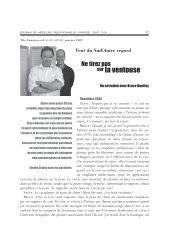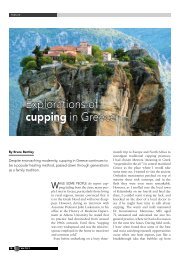Cupping Deficiency - Australian School of Traditional Thai Massage
Cupping Deficiency - Australian School of Traditional Thai Massage
Cupping Deficiency - Australian School of Traditional Thai Massage
Create successful ePaper yourself
Turn your PDF publications into a flip-book with our unique Google optimized e-Paper software.
22<br />
feature<br />
n Muscles <strong>of</strong> the upper back<br />
(Biel, 2010: p.61): The area<br />
<strong>of</strong> deficiency is indicated as a<br />
white circle.<br />
Vol 8-2<br />
<strong>of</strong> the body), and with extension (taking<br />
the arm backwards directly in line from<br />
the side <strong>of</strong> the body), and discomfort and<br />
shortened range <strong>of</strong> movement when his<br />
arm was medially rotated (i.e. bending his<br />
arm and taking it towards his mid-back).<br />
All <strong>of</strong> these restrictions are consistent with<br />
injury sustained to the gleno-humeral joint<br />
with subsequent weakened strength and<br />
flexibility to the teres major, teres minor<br />
and infraspinatus: principal shoulder<br />
stabilising muscles that typically become<br />
problematic in response to injury.<br />
But I was really interested in discovering<br />
if there was a place on Alain that showed<br />
signs <strong>of</strong> deficiency syndrome, whereupon<br />
I could apply tonification cupping. That<br />
proved to be located within a convergence <strong>of</strong><br />
the three previously identified muscles (see<br />
diagram). Palpation and visual observation<br />
are the keys to determining the right place.<br />
Observation revealed that the area had<br />
sunken lower than the regular body level<br />
and from palpation it was noted that: 1.The<br />
skin surface felt cool by comparison with<br />
the surrounding tissue. 2. There was a<br />
distinct collapse <strong>of</strong> muscle tone. 3. Sensitive<br />
penetration revealed errant tissue structure.<br />
This location became my treatment<br />
focus. Briefly the rationale for this is: the<br />
deficiency site undermines all attempts by<br />
the surrounding muscles to be healthy and<br />
to function effectively, because each one<br />
acts as a synergistic lever for all the others.<br />
I will elaborate further on these palpatory<br />
findings during the treatment procedure.<br />
As a CM practitioner not trained in the<br />
complexities <strong>of</strong> osteopathic examination<br />
procedures, I must confess I basically go<br />
with what I feel. I look for the location <strong>of</strong> the<br />
most significant deficiency signs and apply<br />
treatment accordingly. Further, Alain was a<br />
student <strong>of</strong> mine in class and I did not have<br />
the time to go into further examination. In<br />
the course <strong>of</strong> introducing the tonification<br />
cupping method, Alain volunteered for<br />
treatment and gave a brief description <strong>of</strong><br />
his problem. Once all other class members<br />
had the opportunity to palpate the region<br />
and the location and feel <strong>of</strong> the deficiency, I<br />
proceeded with treatment.<br />
Palpation method<br />
Make contact with the skin surface and<br />
inspect throughout the region by gently<br />
palpating the area under examination with<br />
the finger pads. This region being checked<br />
should go beyond the original site <strong>of</strong> the<br />
injury to include a broad expanse <strong>of</strong> the<br />
surrounding surface geography. This is<br />
imperative because <strong>of</strong> the broad ranging<br />
ramifications <strong>of</strong> a complete shoulder<br />
injury, let alone, for example, a simpler<br />
yet still decidedly painful anterior deltoid<br />
tear or strain. Shoulder injury can trigger<br />
a far-reaching disruption to regional s<strong>of</strong>t<br />
tissue integrity and manifest as different<br />
tissue irregularities, for example the<br />
inter-connected spread <strong>of</strong> the surface<br />
fascia (connective tissue) in itself suffers<br />
throughout a surprisingly large coverage <strong>of</strong><br />
subcutaneous tissue.<br />
If you have discovered a site that appears<br />
to be weak, cool/cold, and paler than the<br />
surrounding tissues, gently press into the<br />
site with your index and middle finger tips<br />
or just with your index finger, if there seems<br />
only a small passageway open to go deeply<br />
into. Gently press into the epicentre <strong>of</strong> the<br />
weak tissue and feel for further indicators<br />
<strong>of</strong> deficiency. As you penetrate deeper, you<br />
may find that the coldness and weakness <strong>of</strong><br />
the tissue becomes even more obvious. At a<br />
level where the fingertips have penetrated<br />
about 2-3cm (one inch) into the flesh, halt<br />
and feel for any sensation. In Alain’s case,




